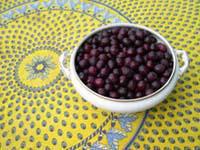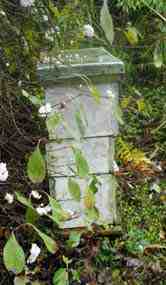Two recipes: Wild Damson Gin and Sloe Gin recipes
Posted by Fiona Nevile in Liqueurs | 714 comments
Wild damsons are a beautiful rich dark colour
Unlike sloes, wild damsons are hard to find. For every thirty wild plum trees there may be just one wild damson tree. When I spot wild damsons in the hedgerows, they are harvested into a special bag.
These, and the diminutive bullace, are the kings of hedgerow fruit. These tiny fruit make such an irresistible liqueur that overnight guests have actually turned down Danny’s famous cooked breakfast, and gone back to bed to sleep off the excesses of the night before.
Our damson and sloe gin is not the thick ultra sweet variety. We prefer the sugar to enhance rather than shield the flavour. Every three months or so it’s sampled and, if necessary, topped up with sugar. Usually no extra sugar is needed.
We try to keep our damson and sloe gin well away from the drinks tray! Each year we make a lot of fruit gin and vodka (more recipes to follow, in time). Sloe gin is the big craze at the moment around here, as sloes are more plentiful.
Here are our recipes for both. We are also starting experimenting with sloe gin see this post for details
Tips and tricks:
- Make more than you need the first year, so you can compare different vintages. This liqueur does improve over time.
- Some people drain the grog through muslin after a couple of months, to clarify the liqueur and bottle. We don’t bother as one old soak tipped that, once the gin is drunk, you can pour medium sherry on the fruit and start all over again! The latter is devilish and drinkable within three months. We have a recipe for this in our wine and gin section.
- Keep your fruit gin away from the light as this will maintain the colour. Unless it is in a dark green or brown bottle. Wrapping it in brown parcel paper will keep out the light.
- Make notes on a label of your fruit gin/vodka /sugar ratio and stick it onto the bottle(s) so that you have a record, if you make a particularly good batch. We note our responses as the grog matures. Yucky after sixth months can be to die for in a year (you will probably not remember without notes). Notes seem boring when you are making the grog but they are so worthwhile when you start again the next year. It won’t be long before you will get a feel of what works well for your taste (and the notes will come into their own).
- Adding almond essence to sloe gin lifts it from good to great. I haven’t tried this with the damson gin but return in a years’ time for our review.
- Don’t kill the liqueur with too much sugar at the start. Use the amount above to start your sloe or damson gin and then every couple of months take a tiny sip. At this time add more sugar if it is too sharp for your taste.
- Gin v Vodka? Vodka can be used as the spirit for these recipes. Although I’m a vodka drinker, we tend to stick to a gin base for our fruit liqueurs.
- A good damson gin can be made from ordinary damsons available in the shops. As they are bigger you would need to put them into a larger Le Parfait jar (I’d use a 2 litre size).
- People have been picking sloes from September 1st around here. Some people say that you shouldn’t pick sloes until after the first frost. This can be circumvented by putting your sloes in the freezer overnight. We don’t bother with either method and always have great results.
- This year we have made up a number of small (1lb honey jars) of sloe gin to give as Christmas presents.
| Wild Damson Gin and sloe gin Recipes |
- Wild damson gin:
- 1lb/454gm of washed wild damsons
- 6 ozs/168gm of white granulated sugar
- 75cl bottle of medium quality gin
- Sterilised 1 litre (at least) Le Parfait jar or wide necked bottle with stopper/cork
- Sloe Gin:
- 1lb/454gm of washed sloes
- 4 ozs/112gm of white granulated sugar
- 75cl bottle of medium quality gin
- Sterilised 1 litre (at least) Le Parfait jar or wide necked bottle
- 1-2 drops of almond essence
- Wild damson gin:
- Wash damsons well and discard any bad or bruised fruit. Prick fruit several times with a fork and place damsons in either a large
- Kilner/Le Parfait jar or a wide necked 1 litre bottle.
- Using a funnel, add the sugar and top up with gin to the rim.
- Shake every day until the sugar is dissolved and then store in a cool, dark place until you can resist it no longer (leave for at least three months, we usually let it mature for a year). If you are planning to drink this after 3 months, have a nip afetr a month, and top up with sugar to taste.
- Some people strain the grog (through muslin/jelly bag) after 3 months and bottle it, leaving it mature for six months. We strain and bottle after a year. Don’t leave the straining process any longer than a year; leaving the fruit in too long can spoil the liqueur, as we found to our cost one year.
- Sloe gin:
- Wash sloes well and discard any bruised or rotten fruit. Prick fruit several times with a fork and place sloes in either a large Kilner/Le Parfait jar or a wide necked 1 litre bottle. I put several sloes in my palm to prick them rather than picking them up one by one.
- Using a funnel, add the sugar and top up with gin to the rim. Always open sugar bags over the sink as sugar tends to get caught in the folds at the top of the bag.
- Add the almond essence.
- Shake every day until the sugar is dissolved and then store in a cool, dark place until you can resist it no longer (leave for at least three months, we usually let it mature for a year).
- Some people strain the grog (through muslin/jelly bag) after 3 months and bottle it, leaving it mature for six months. We strain and bottle after a year.
Leave a reply






Thanks Paul, Ralphy and Matt,
will definitely go for it.
The sloes were so ripe all the stalks were left on the bushes so at least that was one less job to do!
I have frozen them in 2lb batches so I can have 3 different trials running- re sugar, almond etc.
Also Paul I still have my frozen mirabelle left so may as well make this one up at same time.
Has anyone seen xmas gin offers anywhere ?
Last year I made a few batches in early/mid November. The sloes were much riper, and didn’t taste too sour, therefore I used the ratio of Sloes/Sugar on this page and I didn’t need to add much more. I used the squishy ones too and it turned out fine. Only disadvantage is that the Gin isn’t ready for Christmas. I bottled mine in April.
I don’t strain my gin, I just pour it through a funnel to catch the sloes when I am ready to bottle. Therefore I am always careful to pick off all the stems when making my gin. Anyone have experience of whether this is necessary?
Mags,
Just do it! I have made sloe gin fron sloes picked in October to December, pricked them, sorted them, left the stalks on, not pricked them, frozen them, let them frost, soaked them green, used half rotten fruit.
I have never had what one might call a failure; although I have added too much sugar!!! I never use a recipe; throw it in by eye, and it always works; the genius is in the doing-practice makes perfect!-Remember, you can always add sugar………
Hi Mags.
Go for it!
Sloes were traditionally picked after the first frost of the year. Our first frost was last week so I don’t see how you could be too late. Whilst they will clearly be ripe, I find those picked a month or two ago can have a few underripe berries amongst them. I suspect yours will produce a beautiful result and, being ripe, will impart a good strong flavour. I would have used the ripe squidgy ones but I am a YUorkshireman.
Hi All
I’ve only just managed to pick my sloes last Sunday due to hectic disorganised life! shocking I know especially as i had to walk all of 100 metres from my house to get to them!
Picked 3 kg in 1 hour though!!
Have I left it too late? some were a bit squidgy but have disguarded them, I just wanted a general opinion before adding the gin as obviously don’t want to waste it. sloes are pricked and in the freezer, Was going to follow Fiona’s recipe on this page- awaiting your comments, thanks guys
Thanks Ralphy and Matt. The gin isn’t too sour actually but the vodka has a definite kick! If anything the vodka tastes quite like port or brandy, it’s quite a heavy taste. I’ve just added a bit of sugar and will keep tasting (it’s a rubbish job but someone’s got to do it!)
Hi Becky, 2 things you could do;
1. Add a little caster sugar; as this will dissolve much quicker & taste by trial & error, OR;
2. remove some of the liquer into a pan, heat gently & add sugar till it melts – you then get to taste it much faster – but heat sparingly or your alcohol will evaporate!!!
I had the same problem last year with my Sloe Gin. I think you just have to experiment. I started adding 10% extra sugar and then tasting it a few days/weeks later. I then tasted it again and added more sugar as needed until it was to my taste.
If your vodka is really sour, maybe you could add 20% or 30% extra sugar compared to what you put in and try it again a week later. Then repeat if it’s still too sour. The only way is to keep tasting once it’s had time to dissolve properly.
Hi
My elderberry vodka and gin have been maturing for a couple of months now and they definitely need more sugar – I was just wondering how much to add at a time? I don’t want to chuck loads in and make it too sweet! Help much appreciated!
I well recall as a child in the UK a feature of winter days was a spoonful of raspberry vinegar to ward off colds and flu. It seemed to work.
Clearly it was just a local variation of Ralphy’s blackberry vinegar and illustrates how interchangeable many fruits are in recipes.
I suspect my grandmother who made it, preferred to keep her blackberries to go with the apples to make her delicious fruit pies.